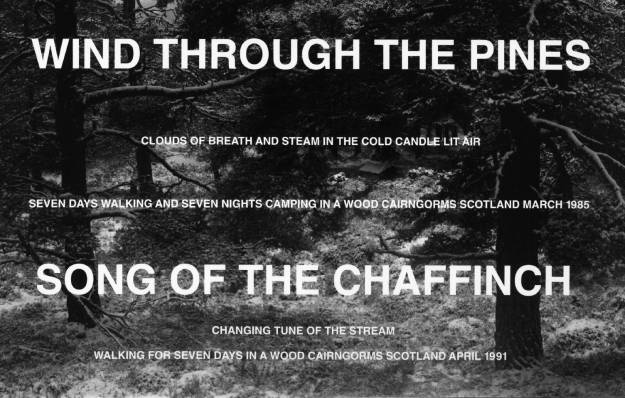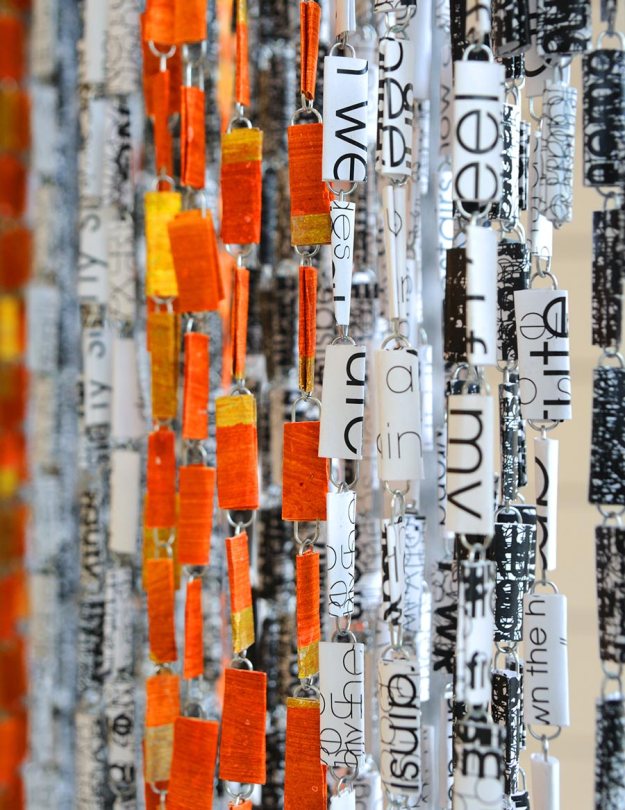Luckily, I managed to get to chat to Maiko on the last day of term on my concerns and options for moving forward with my final show work. We talked on a couple of different points: (i) the use of material and technique, (ii) what the work is communicating, (iii) the ongoing importance of the words/text in my practice
Point (ii) is perhaps the most critical, and based on the group crit of my show work, perhaps the one which is the most illusive. Once again returning to my project objectives, I remind myself that I wanted to communicate:
…the concept of self, by examining the subjective reality we construct as we experience the world. By unravelling our sense of self as strands of multiple co-exisiting identities, I am looking at how these strands are built from places which become part of us through our lives. Shadows of real and imagined places embed themselves into the self, an interconnection of experience, memory and fiction. These shadows haunt us as we pass through the spaces of the world, generating belonging, displacement, familiarity or isolation.
The map weaving has communicated only a single aspect of this idea – that of the real places which are part of my constructed identity. However the fundamental idea of self and the overall feeling of connection or disconnection from the world, is completely obscured from the outside viewer. How then to reveal this?
My first step, has been to consider point (iii) above. Words are clearly so important to me, could I use this as a way of expressing the personal into the more objective ‘universal’ experience of place: If so, how do I want to incorporate text and words into my work? As a label / title only? As a book or accompanying text alongside the sculpture? Or part of the materiality of the weaving itself? As you will have seen if you have been following my progress, I have tried a number of different experiments of including text quite literally as part of the weaving materials. None of these have worked for me at all – which is why I had settled on the idea of doing a book alongside the weavings. So what other options are there out there?
Book Notes: Writing on the Wall, Simon Morley (Thames & Hudson 2003)
I started first with this book, which looks at modern art which combines both word and image. As I would prefer if my words are part of the core aspect of my work (rather than just an ‘aside’ as a label might be perceived as), this seemed like a good place to start.
Morley offers that a work with both word and image engages the viewer in two distinct modes: “one involving the visual scanning of the image and the other the reading of the words. The former mode allows for openness of interpretation and the freedom of mental and sensual movement, while the latter confines the reader to a predetermined route constructed from a horizontal row of letters to be deciphered”. Indeterminacy of meaning is important as ‘misunderstanding creates distance’; texts introduce a reflexive dimension by being both discursive and semantically ambiguous.
Four different kinds of interaction between the visual and the verbal sign can be identified:
- Trans-medial relationship – word and work are connected by superposition, the one is essentially a supplement to the other. Implies a hierarchy where the text remains subordinate to the image (or vice versa).
- Multi-medial: word and image coexist more closely, sharing the same space though remaining clearly distinguished in terms of spatial relations and kinds of intelligibility. For example, the text being used to tie down the specific meaning of an image
- Mixed media: word and image have less intrinsic coherence and are only minimally separated from each other, having been enfolded, decanted or scrambled into each other’s customary domain.
- Inter-media: recognition of the visual, material side of letters (and of the performative and sensory dimension to the act of writing).
Increasingly the inter-medial relationship has also come to signify much more than the melding of the visual and the verbal, into the integration of diverse spaces, movements and sounds [a multi-sensory experience]. Thus such a “total work of art” operates within a vastly expanded field of communication and information.
Resisting legibility
In reading this book, I could see clearly that my asemic calligraphy work fits clearly into the inter-media category. Utilising a desire to engage with “a topographic space”, i.e. a space in which writing is severed from its role as a mere verbal description and is experienced instead as a verbal and visual phenomenon. Expressionism like this makes use of the word’s materiality (the way in which meaning is constituted by the physical arrangement of letters on the page).
Morley comments that there are two poles of the phenomenon of writing:
- legibility, discursive communication and the mind
- illegibility, direct unmediated communication and the pulse of the body
Handwriting, as distinguished from pure typography, printing and so on, has a raw visceral nature, which Morley describes as “an original, personal and expressive outburst”.
For example: Cy Twombly (1971)

and Susan Hiller (Elan, 1982) where “language breaks free”

Concrete Poetry
The next concept which caught my attention in the book, is that of the desire to expand the conventional notion of language and its relationship to other less easily coded experiences. Morley gave reference to the word works of walking artists such as Richard Long and Hamish Fulton, who both try to encapsulate a very personal experience of place within a representation to be viewed in abstract in the gallery space. Photography and words are their medium here, the poetry in the titles or descriptions providing the power to personalise the view.

Wind through the Pines 1985, 1991 Hamish Fulton born 1946 Purchased 1993 http://www.tate.org.uk/art/work/P77621
Fellow ‘land artist’ Robert Smithson also used a combination of words and place, but resisted the use of text as ‘just’ a simple vehicle for ideas, instead drawing contradictions inherent in the word as both signifier and signified, meaning and thing. He is reported to have said “look at any word long enough and you will see it open up into a series of faults, into a terrain of particles each containing its own void”.
The text work of Long and Fulton is often bracketed as concrete poetry (Fulton in particular), that which is neither poetry nor visual art, but rather a fusion of the two. Morley however dominantly covers only two-dimensional forms, which the exception of the well known 3D poetry sculpture of Iain Hamilton Finlay. In many of these works, along with much conceptual art of the 1960’s and 70’s, the words and their meanings are the main material of the work – just think of all of the neon signs and de-materialised works with words plastered on gallery walls. Morley highlighted some works, which although made out of a physical material with its own narrative, still use words to convey some concept or message. For example, the below work from Tracey Emin (Mad Tracey from Margate, Everyone’s Been There, 1997) uses a material which speaks very strongly: in this case, of the so-called ‘feminine’ craft traditions of sewing, applique (and according to Morley of the domestic and amateurish).

Multi-sensory experiences
However, I don’t want to just make words from other materials, so what more can be said about sculpture involving both text and some other physical material with its own ‘readable’ poetic narrative? The fusion of different materials – different visual languages – must sit together side by side, complementary or contradictory depending on the message being communicated.
I had been toying with the idea of doing a larger-scale installation off and on throughout the course and this also seems to be one of the most interesting ways of combining visual languages within the one work. Starting with a literal use of poetry on top of another medium: Francie Hester and Lisa Hill (2016)

Digital words add a whole new scope of possibilities to a work. Morley poetically describes this medium as a “zero-dimensional virtual reality blurring the boundaries between the physical and the virtual, time and space, mind and matter, the natural and the mechanical”. I rather like this idea, and how it naturally gives a multi-layered experience of the work to your audience.
Examples of poetry projected directly onto the landscape, although literal, the history and narrative of the place adds extra layers of meaning onto the work (by Double Take Projections).
And another text projection mapping example from Phillipp Geist, whose projects are characterised by their complexity and the integration of the location, the sound and moving images. “In his video mapping installations, he avoids using canvasses and turns diverse architectures in moving, painterly light sculptures, which challenge the onlookers’ perception of two- and three-dimensionality”.

I am drawn to your idea of a large scale project – your ideas are big and all-embracing and something large would give them wonderful expression
Your Multi-sensory experiences section – with those 3 artists therefore seem very appropriate and exciting
Francie Hester and Lisa Hill, with its fit with Susan Hiller’s “language breaks free” and Double Take Projections and Phillipp Geist introducing music as so much a part of his work – so an opportunity to expand on another of your talents and loves
Going back to communications
How important / essential is communicating ALL that is in your work to others ?Is that actually what is attracting you to the multi sensory artist? That they can do without what
most art in galleries have – a caption or words in a catalogue for those drawn to know more about it? or are these still valuable?
You have made me more aware of how I look at art as an untrained artist
I enjoy /connect with art on an instinctive / immediate visual level before I know anything about it because of patterns/ colours/ objects.
The art we have bought I saw first and bought for these same reasons then added other knowledge about them – but not – but my pleasure is still as great as it was on
first having them
I add this last section for you as future ref re a business woman as input into how one non artist buyer buys art 🙂